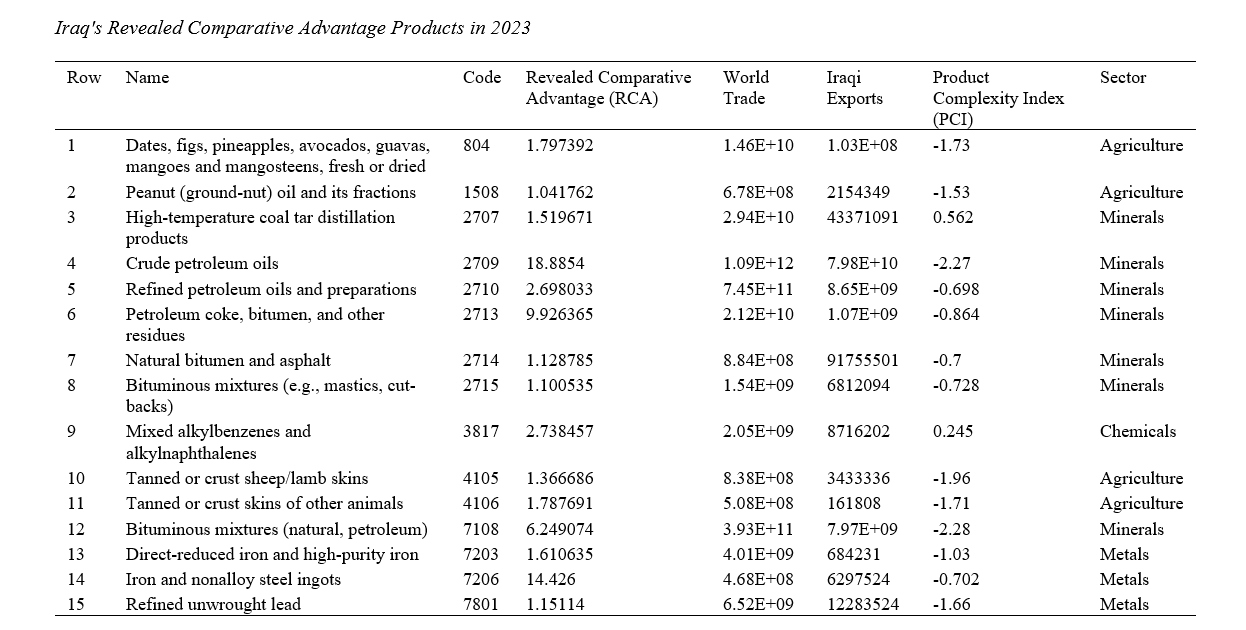Industrial Policy-Making Using Big Data from the Product Space and Network Science
Keywords:
big data, network science, product space, economic complexityAbstract
The global trend of data production and expansion, along with the development of new methods for analyzing big data, has led to the practical application of these methods across various domains, including industrial policy-making. Most existing studies in the field of industrial policy-making have adopted qualitative approaches, with only a few employing quantitative methods. This study applies an economic complexity approach and the product space framework, utilizing big data from 235 countries in the year 2023 based on 1,224 four-digit product codes from the Harmonized System (HS), to design industrial policy for the Republic of Iraq. The findings reveal that Iraq has exhibited revealed comparative advantage (RCA) in the production and export of 15 products, which are primarily raw materials and primary commodities such as oil, minerals, and agricultural goods. By applying network science and the product space model developed by Alshamsi et al., it was also determined that there is potential for Iraq to develop a revealed comparative advantage in 88 additional products. Considering the criteria of positive opportunity gain, product complexity index, and proximity, a total of 11 products were ultimately identified and introduced as emerging opportunities for Iraq.
References
Ahmadian Divkoti, M. M., Aghajani, H., Shirkhodaei, M., & Tehranchian, A. M. (2019). Designing a Model for the Realization of Economic Complexity, Based on the Meta-Analysis of Scientific Research. ROSHD-E-FANAVARI, 15(59), 18-29. https://sid.ir/paper/368007/en
AlOtaibi, E. S., & Sallam, M. A. E. M. (2025). The Impact of Economic Complexity on Economic Development in Saudi Arabia (1991-2021). Ajrsp, 6(69), 80-122. https://doi.org/10.52132/Ajrsp.e.2025.69.4
Alshamsi, A., Pinheiro, F. L., & Hidalgo, C. A. (2018). Optimal diversification strategies in the networks of related products and of related research areas. Nature Communications, 9(1), 1328. https://doi.org/10.1038/s41467-018-03740-9
Azadeh Mansoreh, A. P. (2005). Awareness of Gender Inequality: A Model for Measuring Knowledge of Gender Inequalities. Journal of Women in Development and Politics, 2, 51-73. https://www.unicef.org
Blazquez, D., & Domenech, J. (2018). Big Data sources and methods for social and economic analyses. Technological Forecasting and Social Change, 130, 99-113. https://doi.org/10.1016/j.techfore.2017.07.027
Breen, M., Gillanders, R., McNulty, G., & Suzuki, A. (2017). Gender and corruption in business. The Journal of Development Studies, 53(9), 1486-1501. https://doi.org/10.1080/00220388.2016.1234036
Dadgar, Y. A. U. N. R., & Fahimi, F. (2024). Investigating Iran's Economic Complexity Index and Factors Affecting It: Basic Knowledge in Export. New Approches in Management and Marketing, 2SP - 24, 41. https://doi.org/10.22034/jnamm.2024.428345.1035
Hartmann, D., Bezerra, M., Lodolo, B., & Pinheiro, F. (2020). International trade, development traps, and tye core-periphery structure of income inequality. Economia, 21, 255-278. https://doi.org/10.1016/j.econ.2019.09.001
Javaheri, B., Ghaderi, S., Ghomashi, N., & Amani, R. P. Y. (2024). Investigating the impact of economic complexity and ecological footprint on economic growth in OPEC countries. 24(1), 27-56. http://ecor.modares.ac.ir/article-18-68015-fa.html
Khosravi, A., Karimzade, S., Shahmoradi, B., & Soltanpanah, H. (2020). Optimizing the Export Diversification Strategy of Iran's Chemical Products. Iranian Journal of Economic Studies, 9(2), 595-621DO - 510.22099/ijes.22021.40183.21744. https://ijes.shirazu.ac.ir/article_6260.html
Mayer, S. S., Ibrid, A. A., Kalf, H. A. I., Altememy, H. A., Al-Muttar, M. Y. O., Hammoode, J. A., & Jalil, S. H. (2023). Is financial development having an impact on economic complexity? Empirical study of Iraq. Cuadernos de Economía, 46(131), 135-144. https://cude.es
Ola Alii, A., & Falah khalaf, A. (2022). Analysis of the commodity composition of Iraq's exports using the product space methodology. Journal of Administration and Economics, 1(9), 123-144. https://iasj.rdd.edu.iq/journals/journal/issue/7443
Pinheiro, C. (2025). Relatedness and economic complexity as tools for industrial policy: Insights and limitations. Structural Change and Economic Dynamics, 72, 1-10. https://doi.org/10.1016/j.strueco.2024.09.019
Sagheb, H., Ranjbar, O., & Tari, F. (2023). Iran's Export Opportunities in the Iraqi Market: Integration of Decision Support Model and Approaches of Product Space and Economic Complexity. Industrial Economics Researches, 7(23), 87-106. https://doi.org/10.30473/JIER.2023.68276.1396
Sezai, A. (2020). Evolution of the product space and a new proposal for Turkeys export incentive system. Turkey. Presidency of strategy and budget. https://www.researchgate.net
Simaee, N., Ghazinoory, S., Maleki, A., & Shayan, A. (2021). Which is the Direction of Irans Development? Related or Unrelated Diversification? Journal of Technology Development Management, 9(3), 11-36. https://doi.org/10.22104/jtdm.2022.5163.2867
Syrquin, M., & Chenery, H. (1989). Three decades of industrialization. The World Bank Economic Review, 3(2), 145-181. https://doi.org/10.1093/wber/3.2.145
Tran, L. T., & Freytag, A. (2025). Branding Vietnam: A Product Space Analysis of How Export Diversification Can Shape Up the Country's Sustainable and Innovative Growth. https://doi.org/10.2139/ssrn.5237162
Zobeiri, H. A. U. E. M. (2025). Varieties of Democracy and Economic Complexity in Developing and Developed Countries; A Comparative Study. 25(1), 9. http://ecor.modares.ac.ir/article-18-74026-fa.html

Downloads
Published
Submitted
Revised
Accepted
Issue
Section
License
Copyright (c) 2025 Yad Nawzad Abdullatif (Author); Anvar Khosravi; Kamaran Kasraei (Author)

This work is licensed under a Creative Commons Attribution-NonCommercial 4.0 International License.









